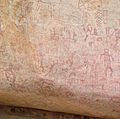Rock art facts for kids
Rock art means human-made drawings, carvings, or paintings found on natural stone. It's a global thing, meaning you can find it in many different cultures all over the world. People have made rock art for thousands of years. Often, it was created as part of special ceremonies or rituals.
Archaeologists usually divide rock art into three main types:
- Petroglyphs are images carved or etched into the rock surface.
- Pictographs are paintings made on the rock surface, often using natural pigments.
- Earth figures are large designs made on the ground, sometimes by moving stones or soil.
The oldest known rock art dates back to the Upper Paleolithic period. This ancient art has been discovered in Europe, Australia, Asia, and Africa. Experts who study these artworks believe they likely had a special meaning, perhaps connected to magic or religion.
Studying rock art became a special field in archaeology in the late 1800s. Scholars in Western Europe first focused on the ancient rock art found in caves. Today, rock art is still very important to indigenous peoples around the world. They see these artworks as sacred and a key part of their cultural history. Rock art sites are also popular places for tourists to visit because of their beauty and historical value.
Understanding Rock Reliefs
A rock relief is a type of sculpture carved directly into a solid rock face, like a cliff. Unlike other rock art, which often comes from prehistoric times, rock reliefs are usually found in cultures that had writing. They are a form of rock art but are often studied separately from the older carvings and paintings made by prehistoric people.
Rock reliefs are usually quite large. They need to be big to be easily seen outdoors. Most figures in rock reliefs are larger than life-size, and some are many times bigger than a person.
These carvings often look similar to other sculptures from the same culture and time period. While most rock reliefs are carved on vertical surfaces, some can be found on horizontal ones too. This term usually doesn't include carvings found inside caves, even if those caves were made by people. It also doesn't include natural rock formations that have been shaped into statues, like the famous Great Sphinx of Giza. However, reliefs carved on large boulders that are still in their natural spot are often considered rock reliefs.
Related pages
Images for kids
-
A petroglyph from Utah, USA, made by the Fremont culture.
-
A reclining Buddha statue carved into rock at Gal Vihara, Sri Lanka.
-
Nanabozho pictograph, Mazinaw Rock, Bon Echo Provincial Park, Ontario, Canada
-
Buddhist stone carvings at Ili River, Kazakhstan
-
Aboriginal rock painting of Mimi spirits in the Anbangbang gallery at Nourlangie Rock in Kakadu National Park.
-
A moose in the rock paintings of Saraakallio in Laukaa, Finland
-
Rock paintings from the Western Cape
-
Rock art in the Adi Alauti cave, Eritrea
-
Native American rock painting close to Douglas, Wyoming, USA. One possible interpretation of this painting is: On the left side a group of United States Army soldiers with different insignia and on the right side Native Americans are shown
-
Bhimbetka rock painting of India, World Heritage Site.
-
'Great King' neolithic paintings above Malipo in Wenshan Prefecture, Yunnan Province, China. Thought to be over 4000 years old.
-
Petroglyphs in Gobustan, Azerbaijan, dating back to 10,000 BC.
-
Gwion Gwion rock paintings in the Kimberley region of Western Australia
See also
 In Spanish: Pintura rupestre para niños
In Spanish: Pintura rupestre para niños



















